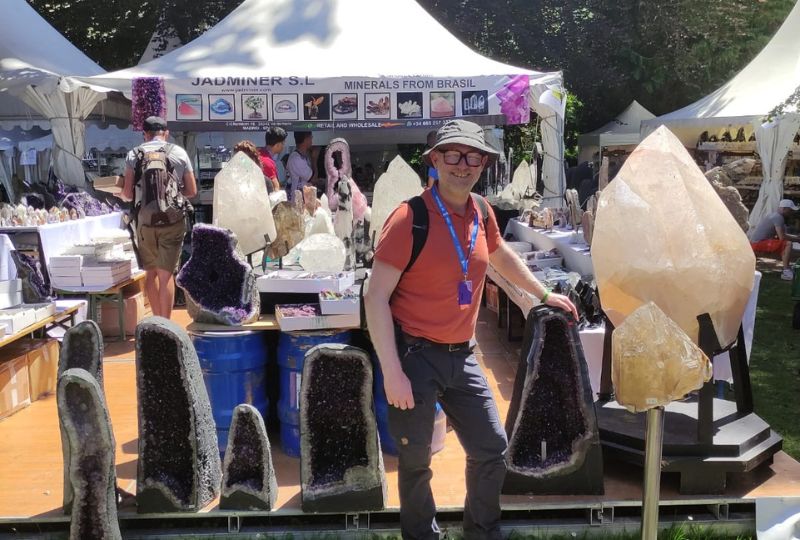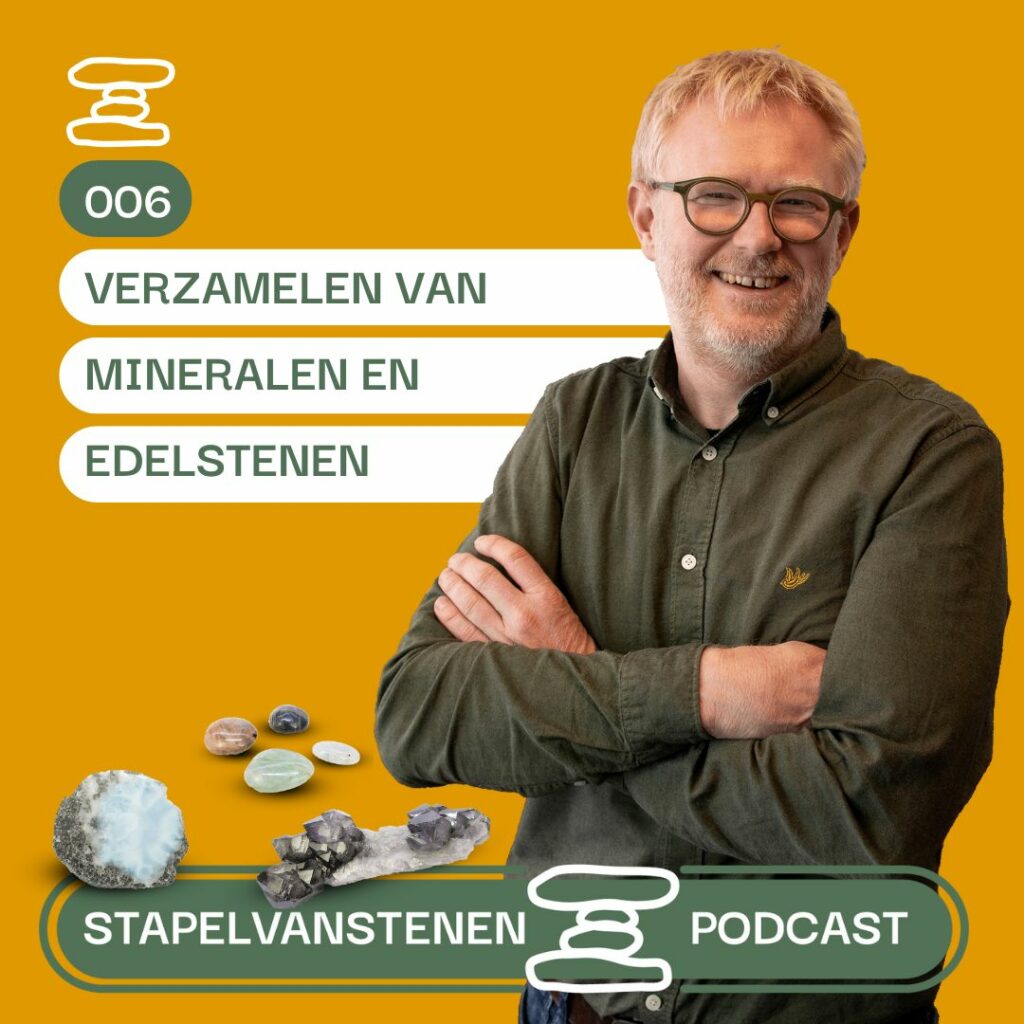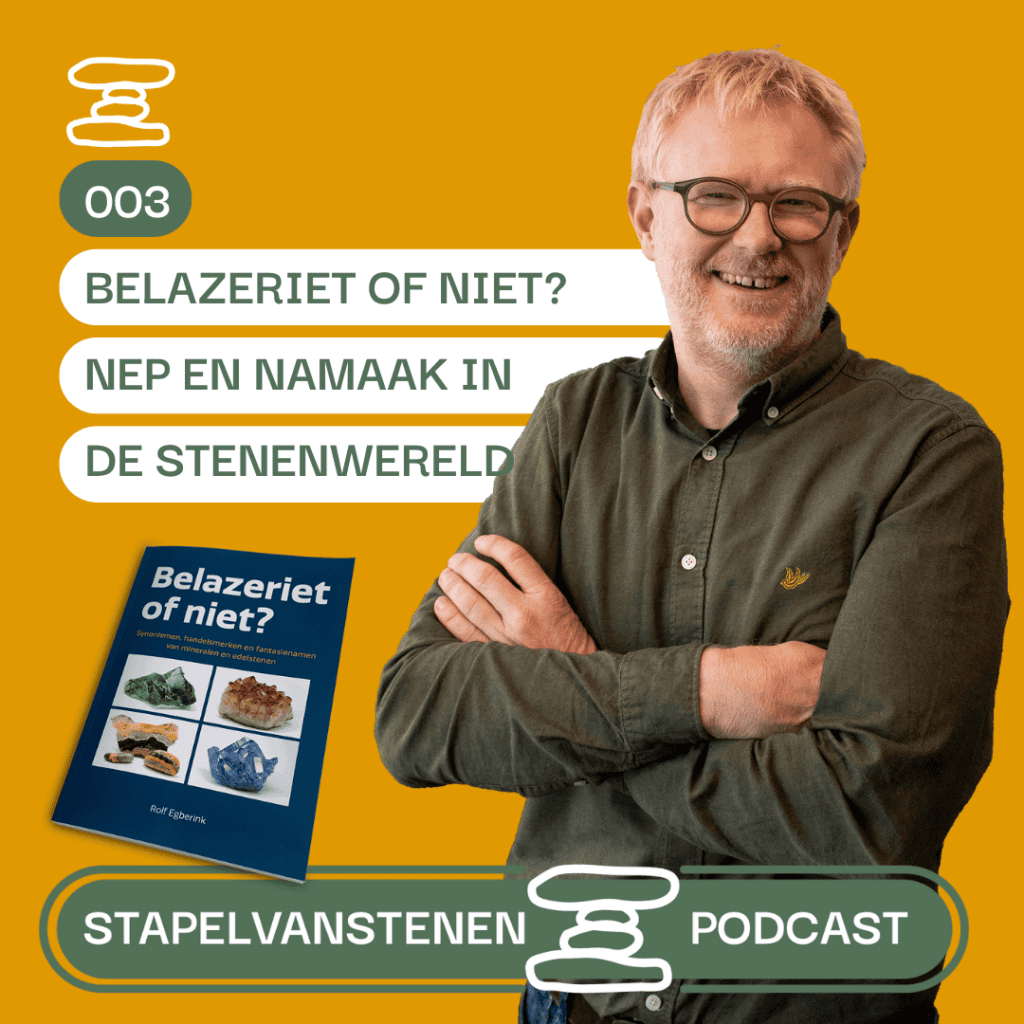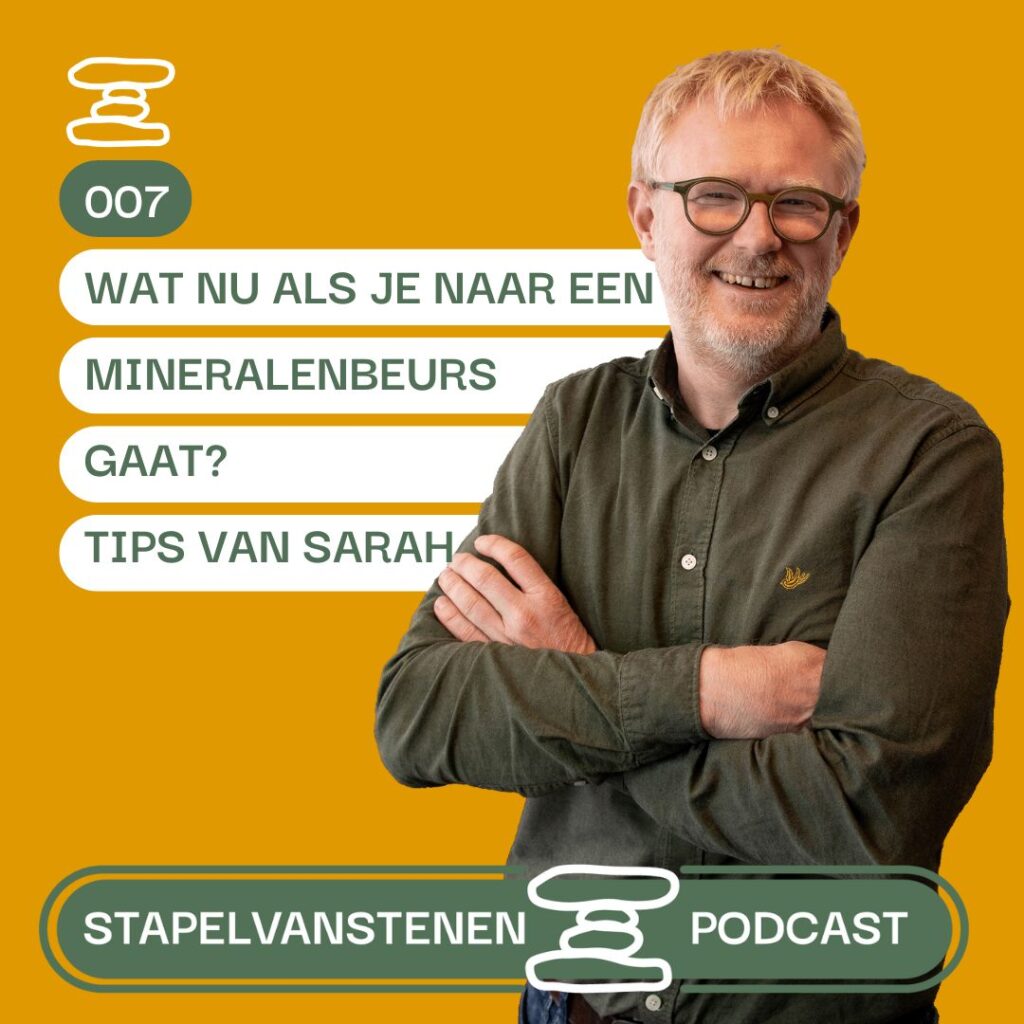Tips for visiting a mineral show

Mineral shows are a melting pot of passion, knowledge and discovery. If you have ever visited a mineral show, you know it is a unique experience: tables and booths full of beautiful gemstones and minerals and enthusiastic collectors and vendors. Many enthusiasts buy their stones at a show, but how can you prepare for a show visit and what should you consider?
For the Stapel van Stenen Community Podcast, we spoke with Sarah from the Edelstenenloods about her experiences at the largest mineral fair in the Netherlands in Rijswijk and the valuable tips she has gathered over the years. Listen to our conversation in the podcast (Dutch).
But of course there was not enough time to discuss everything in the podcast so therefore in this article many more tips for visiting a mineral show.
What show are you going to?
Something we didn’t talk about in the podcast episode, for example, is the multitude of different shows and how to choose which one to go to. After all, during the fall and winter seasons, there is a show almost every weekend somewhere in the Netherlands or the border area. So which one is right for you? Of course, for many people the location plays an important role: is it near me? Logical of course, but there are a number of other considerations you can take into account when making your choice:
- Large and small shows, commercial or not
There are shows of different sizes and organized by different parties, each with its advantages and disadvantages. Consider, for example, the largest mineral fair in the Netherlands in Rijswijk organized by a professional commercial organization. Twice a year a weekend with more than 300 international exhibitors and over 8,000 visitors. But there are also many smaller fairs organized for example by mineral associations, such as the show of Geo Oss in Berghem, the show of Amathysta in Purmerend or the show of Het Kristal in Groningen. Also individual vendors or companies organize shows, such as Mineralogica of the Bodemschat in Hengelo, Mineralenbeurs Hoorn and Mineralenbeurs Steengoed in Boxmeer. The list goes on and on. Each show differs not only in size but also in entrance fees, whether you can buy tickets in advance or not, whether there are catering facilities and of course the range of exhibitors.

- Different offerings and theme shows
The offerings of different shows also vary quite a bit. For example, there are shows that mainly allow sellers of rough mineral specimens for collectors and other shows that have a mix with exhibitors selling rough specimens and cut gemstones and jewelry. There are also very specific shows for certain themes, such as micromount trade shows or spiritual fairs where gems and minerals are a part of a bigger picture. So check in advance what information is available about the show and its exhibitors and whether it suits your purpose. If you would like to meet other collectors, the smaller fairs or shows of mineral associations are often very suitable. There are often sellers there who have collected their own material or sell from their own collection. Especially on the smaller shows in the German and Belgian border area. But at many shows you will also find the more professional sellers or dealers who for example also have a store or webshop. Something for everyone.
- Major international shows
In Europe there are also a number of very large shows where more and more Dutch and Belgian enthusiasts and dealers go. I think the most famous one is the show in Sainte-Marie-aux-Mines in France. A huge show with more than 1,000 international exhibitors in French Alsace. Every year in June the mineral world meets here for a week, the first days only for wholesalers and dealers, the weekend everyone is welcome. Then every October there is a similar show in terms of size in Munich, Germany, but the atmosphere in the large exhibition halls cannot be compared to the French village in summer. Of course, you can also go to the largest mineral fair in the world in Tucson, Arizona, United States. Once long ago, in 1992, I spent two weeks in a hotel there as a vendor. An extraordinary experience, but not comparable to today’s show. In recent years, large shows are also emerging in Asia, curious to see how that development continues. If you have the opportunity, it is absolutely recommended to visit such a large mineral show abroad, maybe you can combine it with a vacation in that region. A great way to meet international dealers with a different offer, to see what’s new on the market and get information from dealers from the country where the minerals come from. These kinds of shows are so huge, though, that you really have to go there well prepared to get the most out of it. Of course, you can also use social media to follow all kinds of people who visit such shows and make videos of them. When it comes to special and exclusive minerals, I personally like the “What’s hot in Sainte Marie/Munich/Tucson?” videos by Blue Cap Productions on YouTube.


Impression of the Sainte-Marie-aux-Mines Show in June 2024
So it depends mostly on what you yourself are looking for at a show, what your goal is. Do you prefer to go to a big crowded show or a more manageable small show? Are you looking for rough collectibles or more polished stones or stones for spiritual purposes? Are you going to buy as a reseller or do you come to the show mainly to look and meet other enthusiasts? Above all, go and experience which show suits you!
On my website you will find an interactive map where, besides stores and wholesalers, a whole number of fair locations are listed in the Netherlands and some in the border area in Belgium and Germany. This way you can easily find a mineral show near you. The map does not show the actual dates of upcoming fairs but it does show the organizer’s details or the website where you can find current info. There are also several vendors, associations or collectors who list a show calendar on their website.
The first step: prepare!
Then, when you know which show you are going to, it is helpful to prepare well for several reasons. Also in the podcast, Sarah emphasizes how important good preparation is before visiting a mineral show. “In the beginning I just jumped in, without any prior knowledge. Afterwards, I realized that it’s much smarter to set a goal for yourself first,” she says. “Ask yourself the question: what do I want to achieve at the show? Maybe you’re looking for a specific mineral or you just want inspiration. It can help to write down your goals or make a wish list. Think of three to five things you want to at least do or purchase.”
Perhaps you have already been to many shows and already have a lot of experience, but there are certainly enthusiasts among you who have not been to many shows yet or are even going to a show for the first time. So here are our tips for you. Do you have more tips? Leave them below in the comments so we can complete the list.
- Beursorganisatie en tickets
- Bekijk eventueel de website van de organisatie van de beurs voor een idee van de locatie, omvang, aantal standhouders, entreeprijs, enz.
- If possible, buy tickets in advance. Especially for crowded fairs like in Rijswijk, this will save you waiting in line! For many large international shows it is also necessary, especially if you want to go to the wholesale days as a vendor. At small fairs in a sports hall or association building, there is usually no ticket reservation and you have to pay cash at the box office. Sometimes there is an ATM, but especially in Germany and Belgium this is often not the case.
- Standhouders en plattegrond
- Zoek op de beurswebsite naar een lijst van standhouders of een plattegrond (en print deze eventueel of bewaar een foto op je telefoon) om je bezoek efficiënt te plannen. Dit is vooral handig bij grote beurzen. Neem eventueel zelfs al vooraf contact op met een verkoper als je specifiek op zoek bent naar iets. De beurzen in Sainte-Marie en München hebben zelfs een eigen app die je kan downloaden met alle informatie bij elkaar.
- Check if there are extra activities at the show such as an exhibition, lectures, demonstrations or children’s activities so you can take them into account when you visit. Nowadays there are often experts present where you can have unknown stones or jewelry identified or tested, so you can take them with you.
- See if vendors or regular suppliers familiar to you will be present, so you can stop by and meet them live. Consult whether you can pick up any items ordered online at the show to save shipping costs.
- Budget en aankopen
- The offerings and temptations at a show are huge. So set a budget for yourself in advance and, if necessary, take only cash with you to limit impulsive purchases. But beware, because in Rijswijk, for example, you can only pay with debit card at the catering.
- Maak een verlanglijst van mineralen of stenen die je zoekt om gericht te kopen. Maar sta eventueel open voor een onverwacht mooi aanbod of een bijzondere vondst dat je niet kan afslaan. Kijk vooraf online naar voorbeelden en gangbare prijzen van wat jij graag wil kopen om een realistische inschatting te maken en je verwachtingen te managen.
- Cash is King. Although more and more shows and exhibitors have ATM machines, it is wise to bring enough cash. Especially at smaller fairs, not only in Germany and Belgium, the possibilities to pay by card are often limited. But even at a large fair such as in Rijswijk, the experience is that internet reception of ATMs is not always optimal and that the ATM in the hall of the venue is empty during the weekend. I have seen the same thing in Sainte-Marie, on Wednesday already empty ATMs in the village. Moreover, cash is most convenient for many exhibitors, debit card transactions cost money and they too sometimes need the cash again to buy from their dealers.
- Samen naar een beurs gaan
- Wanneer je nog nooit op een mineralenbeurs bent geweest of wanneer je het een uitdaging vindt om alleen te gaan, overweeg dan om samen met iemand te gaan of ter plekke af te spreken met andere liefhebbers. Wat is er leuker dan mensen uit mijn online community of een Facebook groep in real life te ontmoeten.
- In addition to socializing, you can of course give each other tips or advice on purchases and check out each other’s acquisitions over coffee.
- Wat neem je mee naar een mineralenbeurs?
- Niet teveel, want je komt sowieso met meer terug dan je kwam!Uiteraard afhankelijk van hoeveel je denkt te gaan kopen, maar neem in ieder geval iets mee waarin je je aankopen mee terug kan nemen. Niet elke standhouder geeft een tas mee en een aantal stenen bij elkaar wegen al snel het nodige. Een grote rugzak lijkt handig maar wordt door andere beursbezoekers in een druk gangpad niet altijd gewaardeerd. Hetzelfde geldt voor een boodschappenwagentje of een rolkoffertje. Houd dan in ieder geval rekening met de andere bezoekers. Een stevige schoudertas lijkt voor de meeste mensen een prima oplossing. Bezoekers die groot gaan inkopen op de grote internationale beurzen zoals in Sainte-Marie-aux-Mines nemen natuurlijk bijpassende spullen mee, zoals een bolderkar met luchtbanden of zelfs steekkarren en pallet wagens. Neem eventueel een loep mee om goed kristallen te kunnen bekijken of geslepen oppervlakken te inspecteren op beschadigingen. Misschien zelfs een zaklampje om heldere stenen goed te inspecteren op insluitsels bijvoorbeeld. Voor de liefhebbers van fluorescerende mineralen kan een goede UV-lamp niet ontbreken, bovendien kun je nog wel eens verrast worden door het effect van een steen als je met een UV lamp op schijnt. Een UV-lamp kan trouwens soms ook handig zijn bij determinatie of om gelijmde of gekleurde stukken te identificeren. Je verlanglijst, doelen of te bezoeken contacten voor deze beurs, ik gebruik daar zelf altijd mijn notities in mijn telefoon voor. Ook zorg ik dat ik mijn collectie database kan raadplegen, ofwel een kopie van Excel ofwel mijn online database in Mindat. Dan kan ik snel vinden of ik een bepaald mineraal al in mijn collectie heb en van welke vindplaats.
- Consider your own comfort: bring water and something to eat, and dress airily because of the heat on the show floor. With all the lights and the amount of people, it can get hot inside quickly. Many shows have some sort of catering facility, but it can range from just coffee to a hot meal or snacks. Of course, prices of these also vary greatly.

The fair itself: tips for a smooth day
Yes, and then you arrive at the show and then what: how do you start? Depending on your experience and the size of a show, your strategy may be different. But, once at the fair, it can be quite overwhelming, especially if it’s your first time at such a large fair like in Rijswijk or abroad. “In Rijswijk there are more than 300 exhibitors, and that’s quite a lot,” Sarah says. It’s tempting to dive straight into the first booth, but Sarah recommends sticking to your plan. “Start with your priorities and only then work down your list,” she says.
- Strategie
- Bedenk op welke tijd je aankomt. De eerste beursdag direct om 10 uur als de beurs open gaat is het druk, soms heel druk. Een half uur of een uur later kan net het verschil maken. Ook helpt het wanneer je een ticket vooraf gekocht hebt: geen wachtrij voor de kassa.
- Stem je strategie af op je doelen en de soort beurs. Heb je helder wat je eerst wil zien of heb je een plan gemaakt aan de hand van een plattegrond: volg je plan! Systematisch de gangpaden doorlopen om niets te missen kan natuurlijk ook, maar onze ervaring is dat het op een grote beurs niet lukt om alles te zien. Snel scannen helpt om interessante stands te identificeren, zeker als je gericht op zoek bent naar bijvoorbeeld ruwe stukken of juist geslepen stenen. Bij een kleinere, overzichtelijke beurs is er vaak voldoende tijd en ruimte om alles rustig te bekijken.
- Soms werkt het goed om eerst door te lopen naar achteren en van achter naar voor te lopen, zeker als je in de ochtend komt en het achterin nog rustig is, de meeste mensen beginnen namelijk toch vooraan.
- Wanneer er activiteiten zijn waar je graag aan mee wil doen of bij wil zijn, zoals demonstraties of lezingen, kijk dan op welke tijden dit plaatsvindt en zet eventueel een alarm op je telefoon. De start van dergelijke activiteiten wordt vaak niet omgeroepen en je vergeet snel de tijd als je een keer langs de stands loopt.
- Take breaks, allow yourself a moment now and then to have a cup of coffee or take a breath of fresh air outside, consider a purchase or put everything together.
- Een aankoop doen
- If you see something from your list, the price matches your expectations and it fits within your budget: breeze! If not, still try to stick to your list and at least your budget… But we all know those pieces for which you still want to deviate from your principles. Only you can decide that, but don’t be tempted by the fear of missing something (FOMO). You can often find another appropriate piece, even if the “best piece” is already gone. Take the time to compare prices and think about your purchases. If you are seriously interested, you may want to ask a seller for time to think about or reserve a piece, just agree on a reasonable time when you will return.
- Wanneer je een foto wil maken om bijvoorbeeld een bepaald stuk te onthouden of om even te overleggen met het thuisfront of een collega liefhebber, vraag dan altijd even netjes aan de verkoper of dat ok is. Ik zie namelijk steeds meer stands waar een bordje staat dat het niet is toegestaan om foto’s te maken. Dat kan allerlei redenen hebben, van concurrentiebeding tot veiligheid.
- Talk to the sellers, ask questions and learn from their expertise. Many sellers are themselves passionate about the minerals they have sourced or found themselves, so you can have wonderful conversations. You can also get a lot more information about a piece that way. For example, ask if they can tell you more about the species, where it was found and whether the stone is natural, man-made or treated. Especially with “new” or “rare” minerals, it is good to ask a little more. Also pay attention to the use of commercial (sometimes misleading) trade names and use your common sense or sources such as the book “Belazeritet of niet?” (Gem or Scam?) to avoid coming home with something other than what you expected. If you go to shows more often, you will encounter certain vendors on a regular basis. If you buy from the same vendor more often and have a chat, you will build a relationship, which can certainly be rewarding.
- Ask the seller if you can take a closer look at a piece and preferably have the seller hand you the piece, especially if it is on a glass plate among all sorts of other (precious) pieces. Look for intact crystals, clarity, inclusions, possibly the quality of the cutting and polishing, and so on. Use your tools such as a magnifying glass or UV lamp to inspect details.
- A seller has placed a certain price on a piece for a reason. That price depends not only on the quality or rarity of a piece, for example, but also on the purchase price, costs incurred by the seller and whether or not the seller has to pay VAT. A price for similar pieces at different sellers can therefore also be different. Therefore, it is not always appreciated when you start negotiating the price right from your first and single purchase. However, if you are a returning customer or if you make several purchases, you can discuss the price with many sellers. And, of course, you can always ask why a piece has a certain price; you learn a lot from that too.
- If the stone is not labeled with the name and location, ask the seller to write it down for you to avoid forgetting what you bought. A species name can often be retrieved, but a location is more difficult, and location information is crucial for a serious collector. Then, of course, you want a piece to be well packed so that you get it home in one piece. Sometimes it is convenient to leave a very large or heavy piece behind the seller’s booth so you can pick it up at the end of the exhibition day.
- Identifying and testing stones
- At most shows these days there are experts who can identify or test stones, take advantage of this! If you have bought a mineral or a cut gemstone, but you have doubts about what exactly it is or whether it is treated or non-natural, these experts can often help you further. On site they can do some tests and often already give you more information about your purchase, sometimes more extensive research is needed. You can then return to the seller with your purchase if necessary. At the fair in Rijswijk, Stapel van Stenen has a booth together with gemologist Henk Rijneveld FGA to test and identify stones.
- Ontmoeten en netwerken
- De beurs is een perfecte plek om gelijkgestemden te ontmoeten, bijvoorbeeld andere liefhebbers vanuit online groepen, verenigingen, verzamelaars en uiteraard verkopers.
- Meet with people in advance or use a spontaneous meeting to take a break.
- Many exhibitors have business cards at their booths, bring them with you but preferably also write on them why you brought that very card!


Ask the seller to give you a piece to look at and look for the opportunity to have your stone tested or identified (Rolf Egberink and Henk Rijneveld FGA in Rijswijk, October 2024)
After the show: process your experiences
Sarah stresses the importance of reflection after your mineral show visit. “Write down what you saw, who you talked to, and what you learned. That way you can always look back on your experiences later and make follow-up appointments if necessary.” She also advises keeping contact information of interesting people, whether they are vendors or fellow enthusiasts. “Send them a message within a week of the trade show to keep the connection warm. Who knows, maybe you’ll meet again at the next trade show!”
- Unpacking and checking
- When you get home with your new acquisitions unwrap them and then take a closer look. Is the piece still intact and is it the right piece you bought? Is the label or name attached? Shortly after the show you can still contact the seller, don’t wait too long.
- Sharing your purchases
- It can be fun to share with others what acquisitions you’ve bought, for example through social media. Then when you also tag the seller in it, that’s fun advertising and interaction with the community for them as well.
- Social media en beurservaringen
- Door het delen van foto’s en video’s van jouw beursbezoek kun je mensen die de beurs niet konden bezoeken er toch bij betrekken. Daarmee kun je wellicht ook anderen enthousiast maken om eens een beurs te bezoeken en kun je reclame maken voor de beursorganisatie of bepaalde verkopers.
- Especially from international trade shows that not everyone can attend, it’s fun to share your experiences. There is a lot on social media these days, think of the videos like “Come and visit the gem show with us” or “Shop like a dealer at the Denver Mineral Show” on media like TikTok, Instagram and Facebook.
A mineral show is more than just a place to buy stones. It is an experience full of meeting, learning and discovery. Whether you are a seasoned collector or taking your first steps into the world of minerals, with the right preparation and an open attitude, you will get the most out of your visit. So grab your magnifying glass, ask your questions and enjoy all that a mineral show has to offer!
Do you have any questions or tips? Write your comment below.
If you want to connect with other gem and mineral enthusiasts to share your experiences or ask questions (or perhaps plan your next trade show visit), join the free enthusiast community of Stapel van Stenen!
Test






Responses